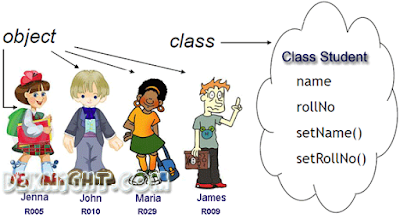Object means a real word entity such as pen, chair, table etc. Object-Oriented Programming is a methodology or paradigm to design a program using classes and objects.

It simplifies the software development and maintenance by providing some concepts:

It simplifies the software development and maintenance by providing some concepts:
Object
Class
Inheritance
Polymorphism
Abstraction
Encapsulation
2- What is polymorphism?
Polymorphism in java is a concept by which we can perform a single action by different ways. Polymorphism is derived from 2 greek words: poly and morphs. The word "poly" means many and "morphs" means forms. So polymorphism means many forms.
There are two types of polymorphism in java: compile time polymorphism and runtime polymorphism. We can perform polymorphism in java by method overloading and method overriding.
If you overload static method in java, it is the example of compile time polymorphism. Here, we will focus on runtime polymorphism in java.
1- Runtime polymorphism or Dynamic Method Dispatch is a process in which a call to an overridden method is resolved at runtime rather than compile-time.
Class
Inheritance
Polymorphism
Abstraction
Encapsulation
2- What is polymorphism?
Polymorphism in java is a concept by which we can perform a single action by different ways. Polymorphism is derived from 2 greek words: poly and morphs. The word "poly" means many and "morphs" means forms. So polymorphism means many forms.
There are two types of polymorphism in java: compile time polymorphism and runtime polymorphism. We can perform polymorphism in java by method overloading and method overriding.
If you overload static method in java, it is the example of compile time polymorphism. Here, we will focus on runtime polymorphism in java.
1- Runtime polymorphism or Dynamic Method Dispatch is a process in which a call to an overridden method is resolved at runtime rather than compile-time.
2- Compile time Polymorohism - If a class have multiple methods by same name but different parameters, it is known as Method Overloading.
3- What is multiple inheritance and does java support?
If a child class inherits the property from multiple parent classes is known as multiple inheritance. Java does not allow to extend multiple classes, to overcome this problem it allows to implement multiple Interfaces.
4- What is an abstraction ?
Hiding internal details and showing functionality is known as abstraction. For example: phone call, we don't know the internal processing. In java, we use abstract class and interface to achieve abstraction.
5- What is Encapsulation?
Binding (or wrapping) code and data together into a single unit is known as encapsulation. For example: capsule, it is wrapped with different medicines.
A java class is the example of encapsulation. Java bean is the fully encapsulated class because all the data members are private here.
6- What is Association?
It represents a relationship between two or more objects where all objects have their own lifecycle and there is no owner. The name of an association specifies the nature of relationship between objects. This is represented by a solid line.

Let’s take an example of relationship between Teacher and Student. Multiple students can associate with a single teacher and a single student can associate with multiple teachers. But there is no ownership between the objects and both have their own lifecycle. Both can be created and deleted independently.

8- What is Aggregation?
It is a specialized form of Association where all object have their own lifecycle but there is ownership. This represents “whole-part or a-part-of” relationship. This is represented by a hollow diamond followed by a line.

Let’s take an example of relationship between Department and Teacher. A Teacher may belongs to multiple departments. Hence Teacher is a part of multiple departments. But if we delete a Department, Teacher Object will not destroy.

|
|

No comments:
Post a Comment